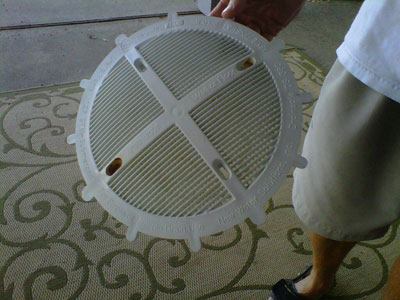The venue: The entrapment occurred in a kiddie pool at the Langf…
Crucial questions are surfacing about an entrapment that took place at a public pool in Nashville.
On July 3, a four-year-old girl apparently sat on a suction outlet in a wading pool at the Langford Farms Swim Club. The single-drain pool was approximately 12 inches deep, according to the Tennessee Health Department. Local media reported that relatives realized the child was in trouble when they noticed she was having a hard time keeping her head above water. The child survived but sustained internal injuries.
Contradictory information has circulated about the safety devices in place in the pool.
At the time of the entrapment, the Drainsafe DS 360 drain cover was not completely attached to pool’s floor, according to the inspection report from the Tennessee Department of Health. The fitting is VGB-approved and one of the few models not included in last year’s CPSC drain-cover recall.
Industry observers who have viewed photos on the local news coverage believe the drain cover likely was not installed correctly.
“The cover that they showed in the video, which according to the inspector was the cover for the wading pool, had two rust spots in two of the ports where the screws go in,” said Ron Schroader, principal of Drainsafe/New Water Solutions in Lake Worth, Fla. “The [other] two ports had never had screws installed in them from what I could see when they magnified the picture.”
The proper screws, made of 316 stainless steel, are provided with the DS 360, according to Schroader. “316-grade stainless doesn’t rust — it dissolves,” he said. “It doesn’t leave a rusty iron patch behind. So it wasn’t our screws.”
Using proper, manufacturer-supplied screws is vital to ensure the cover remains in place. Some past entrapments have been caused by use of improper screws that failed and caused the cover to become dislodged. The standard for testing drain covers, ANSI/APSP-16, specifies that any screws used to attach suction outlet covers be made from 316-grade stainless steel. The screws also must have at least three threads.
Contradictions also have arisen about the safety vacuum release system installed on the pool.
At the time of the entrapment, the wife of the facility’s owner told local media that the pool complied with the Virginia Graeme Baker Pool and Spa Safety Act and that it had a safety vacuum release system. She also said that the SVRS shut off the pump when the entrapment occurred.
However, Health Department officials now say the pump was turned off manually, and that the act of shutting it off is what freed the child.
Additionally, the investigation showed that the front panel of the SVRS device — made by Stingl Products — had a message reading, “Set-up Required! Call for service.”
But this message is only seen when the device is first being installed, and it only appears once, according to an official with Stingl.
This leads the firm to believe the SVRS had been bypassed.
“[The ‘Set-up Required’ message] is the first screen that comes on when the unit has power applied to it,” said Anthony Sirianni, president of Stingl Products in Sterling, Va. “It’s the first thing that comes up in the calibration process … and you never see that screen again. Ever.”
He added that the device never would have operated without being calibrated first, and that a different message would have displayed if a change in vacuum had been detected.
If the Stingl device had detected a problem, Sirianni said, it would have shut the pump down in 600 milliseconds.
Calls to the Langford Farms Swim Club were not returned by presstime.
The Consumer Product Safety Commission also is investigating the incident. Though the agency has not levied fines in the past, it has the authority to heavily penalize violators.
In Tennessee, public pools are inspected once every calendar month when they are in operation, according to Hugh Atkins, Director of the Division of Environmental Health for the Tennessee Department of Health.
Before the entrapment incident, the Langford Farms pool had last been inspected June 6 and there were no indications of a loose or missing drain cover. The pool in which the incident occurred is currently drained and closed.






